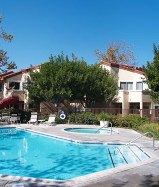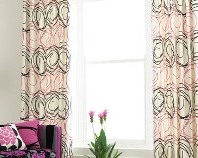Materials Matter in Interior Design
 September 13, 2011
September 13, 2011 
Granite or marble is what usually comes to mind when people think about luxury stone materials for the kitchen or bathroom. While they are still very popular, there are many other exciting alternatives that are out in the market today. To name a few, there’s quartz, soapstone, resin, semi-precious stones, and even recycled glass.
One of the most eye-catching, if not the most spectacular, is the surface material made of semi-precious stones. Yes, semi-precious stones, the same materials used for jewelry. Majestic Gemstone from Israel presents agates, jaspers, amethysts, sodalite, and carnelian in their collection. Shown in the above photo is their blue agate stone slab. Majestic Gemstone handpicks their stones from around the world and sends it to their manufacturing plant to have it cut into 2-3 cm thick slabs and joined together with epoxy glues.
The wonderful feature about these semi-precious stones is their translucent quality. You can insert a light under the slab and backlight the stones, allowing the stones to glow even more.


Zodiaq, a surface material from DuPont, is made of quartz crystals and acrylic resin, and like the starry heavens it refers to, the material shimmers luminously. Available in a variety of colors, Zodiaq is shown in the above photo in Indus Red. Zodiaq is tough and resistant to heat and scratches, making it ideal for kitchen countertops.
 Another material, soapstone, has been around for centuries. Soapstone, also known as steatite, is metamorphic rock. It is made up mostly of talc, a soft mineral, and hence can be carved into a myriad of forms. Native Americans used it for their carvings, the Vikings for their cooking pots, and even the early Minoans used it to build a banquet table. Designers and manufacturers have been rediscovering soapstone and are now specifying it for use for kitchen countertops, bathroom sinks, and vanity counters. The main advantage of soapstone is that it is non-porous and hence resistant to staining from liquids, unlike granite or marble, making it a perfect choice for kitchen countertops. The only disadvantage to soapstone is its limited color palette, only ranging from blacks to grays, and soft muted blues and greens. But soapstone is a very elegant material that complements all kinds of décor.
Another material, soapstone, has been around for centuries. Soapstone, also known as steatite, is metamorphic rock. It is made up mostly of talc, a soft mineral, and hence can be carved into a myriad of forms. Native Americans used it for their carvings, the Vikings for their cooking pots, and even the early Minoans used it to build a banquet table. Designers and manufacturers have been rediscovering soapstone and are now specifying it for use for kitchen countertops, bathroom sinks, and vanity counters. The main advantage of soapstone is that it is non-porous and hence resistant to staining from liquids, unlike granite or marble, making it a perfect choice for kitchen countertops. The only disadvantage to soapstone is its limited color palette, only ranging from blacks to grays, and soft muted blues and greens. But soapstone is a very elegant material that complements all kinds of décor.

One of the most flexible and exciting surface material is synthetic resin. Resin first starts out as a liquid polymer. A fabricator then casts it into a mold for shaping and then the resin solidifies into a very hard substance. Its biggest attraction is that resin can be pigmented in any color and a designer can add various additional materials such as other stones, shells, photos, feathers – you name it – to amp up its uniqueness. In the photo above we have a cast resin bar top from the Martini Bar. Since you can mold its shape into just about anything – you can also create a variety of objects, like this lamp from Atta, Inc. Resin is also translucent and so light can shine through the material making it great for accent lighting.

Make some exciting choices when looking for surface materials for your kitchen or bathroom. There are so many unique materials available now that you don’t need to be limited to the old standbys of granite, marble or even porcelain tile anymore.
 Interested in learning more about materials and design? Take a look at Sheffield School's Complete Course in Interior Design. At Sheffield, you'll learn how to transform a space, create color schemes, and select furniture, lighting, and accessories.
Interested in learning more about materials and design? Take a look at Sheffield School's Complete Course in Interior Design. At Sheffield, you'll learn how to transform a space, create color schemes, and select furniture, lighting, and accessories.
 DuPont,
DuPont,  Sheffield School,
Sheffield School,  resin,
resin,  stone in
stone in  new products
new products 












Reader Comments (2)
I currently work for an Architectural Firm. I can not count how many times clients call with questions regarding unique material to use in their Kitchens and Bathrooms. This article has given me a number of different materials that would work great in these spaces.
Thanks for sharing!
The furnitures in the 3rd picture is so nice!